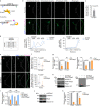Cytosolic Ptbp2 modulates axon growth in motoneurons through axonal localization and translation of Hnrnpr
- PMID: 37438340
- PMCID: PMC10338680
- DOI: 10.1038/s41467-023-39787-6
Cytosolic Ptbp2 modulates axon growth in motoneurons through axonal localization and translation of Hnrnpr
Abstract
The neuronal RNA-binding protein Ptbp2 regulates neuronal differentiation by modulating alternative splicing programs in the nucleus. Such programs contribute to axonogenesis by adjusting the levels of protein isoforms involved in axon growth and branching. While its functions in alternative splicing have been described in detail, cytosolic roles of Ptbp2 for axon growth have remained elusive. Here, we show that Ptbp2 is located in the cytosol including axons and growth cones of motoneurons, and that depletion of cytosolic Ptbp2 affects axon growth. We identify Ptbp2 as a major interactor of the 3' UTR of Hnrnpr mRNA encoding the RNA-binding protein hnRNP R. Axonal localization of Hnrnpr mRNA and local synthesis of hnRNP R protein are strongly reduced when Ptbp2 is depleted, leading to defective axon growth. Ptbp2 regulates hnRNP R translation by mediating the association of Hnrnpr with ribosomes in a manner dependent on the translation factor eIF5A2. Our data thus suggest a mechanism whereby cytosolic Ptbp2 modulates axon growth by fine-tuning the mRNA transport and local synthesis of an RNA-binding protein.
© 2023. The Author(s).
Conflict of interest statement
The authors declare no competing interests.
Figures









Similar articles
-
Ptbp2 re-expression rescues axon growth defects in Smn-deficient motoneurons.Front Mol Neurosci. 2024 Aug 23;17:1393779. doi: 10.3389/fnmol.2024.1393779. eCollection 2024. Front Mol Neurosci. 2024. PMID: 39246602 Free PMC article.
-
hnRNP R and its main interactor, the noncoding RNA 7SK, coregulate the axonal transcriptome of motoneurons.Proc Natl Acad Sci U S A. 2018 Mar 20;115(12):E2859-E2868. doi: 10.1073/pnas.1721670115. Epub 2018 Mar 5. Proc Natl Acad Sci U S A. 2018. PMID: 29507242 Free PMC article.
-
The heterogeneous nuclear ribonucleoprotein-R is necessary for axonal beta-actin mRNA translocation in spinal motor neurons.Hum Mol Genet. 2010 May 15;19(10):1951-66. doi: 10.1093/hmg/ddq073. Epub 2010 Feb 18. Hum Mol Genet. 2010. PMID: 20167579
-
Local translation and mRNA trafficking in axon pathfinding.Results Probl Cell Differ. 2009;48:269-88. doi: 10.1007/400_2009_5. Results Probl Cell Differ. 2009. PMID: 19343311 Free PMC article. Review.
-
Axonal mRNAs: functional significance in vertebrates and invertebrates.J Neurocytol. 2000 Nov-Dec;29(11-12):783-91. doi: 10.1023/a:1010987206526. J Neurocytol. 2000. PMID: 11466470 Review.
Cited by
-
Ptbp2 re-expression rescues axon growth defects in Smn-deficient motoneurons.Front Mol Neurosci. 2024 Aug 23;17:1393779. doi: 10.3389/fnmol.2024.1393779. eCollection 2024. Front Mol Neurosci. 2024. PMID: 39246602 Free PMC article.
-
Cortical projection neurons with distinct axonal connectivity employ ribosomal complexes with distinct protein compositions.bioRxiv [Preprint]. 2025 May 1:2024.12.22.629968. doi: 10.1101/2024.12.22.629968. bioRxiv. 2025. PMID: 39763931 Free PMC article. Preprint.
-
hnRNP R promotes O-GlcNAcylation of eIF4G and facilitates axonal protein synthesis.Nat Commun. 2024 Aug 28;15(1):7430. doi: 10.1038/s41467-024-51678-y. Nat Commun. 2024. PMID: 39198412 Free PMC article.
-
hnRNPs: roles in neurodevelopment and implication for brain disorders.Front Mol Neurosci. 2024 Jul 17;17:1411639. doi: 10.3389/fnmol.2024.1411639. eCollection 2024. Front Mol Neurosci. 2024. PMID: 39086926 Free PMC article. Review.
-
Sex-specific perturbations of neuronal development caused by mutations in the autism risk gene DDX3X.Nat Commun. 2025 May 15;16(1):4512. doi: 10.1038/s41467-025-59680-8. Nat Commun. 2025. PMID: 40374608 Free PMC article.
References
Publication types
MeSH terms
Substances
LinkOut - more resources
Full Text Sources
Molecular Biology Databases

